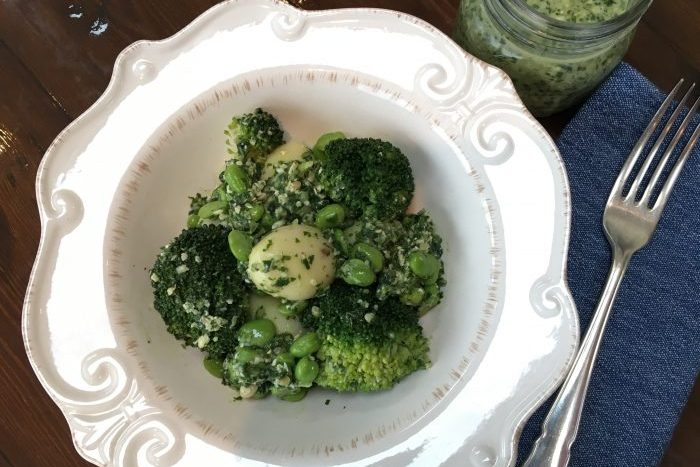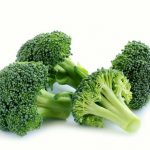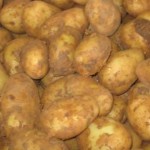A vibrant, quick and delicious side dish or lunch option.
If you want to keep it a simple, no-cook option then tinned new potatoes work well. Otherwise boiling or steaming some beautiful new baby potatoes whilst retaining their skins will provide more nutrients.
Skills Check
Follow a recipe; follow food safety & hygiene rules; tidy away; use measuring jugs and spoons; use weighing scales; cut using bridge/claw technique safely; use a tin opener safely; use a citrus squeezer; use a blender (with adult supervision).
Allergens
Tree Nuts
(Please note the allergens listed are indicative only. Allergens vary depending on brand; check the labels on the products you use.)
Equipment
Blender, large mixing bowl, measuring spoons, weighing scales, tin opener, spoon.
Ingredients (serves 2):
- 345 g new potatoes, cooked (tinned or fresh)
- 150 g broccoli, raw
- 150 g frozen broad beans, defrosted
- 50 g basil
- 20 g pine nuts
- 1 clove of garlic
- Juice of 1/2 a lemon
- 1 tsp water
Method
- To make the pesto put the basil, pine nuts, garlic lemon juice, olive oil and water in a blender and blitz until you have a fairly chunky consistency.
- Place the potatoes, broccoli and broad beans into a bowl and pour over the pesto.
- Mix gently to coat the vegetables and serve.

 So thinking about Easy Greens & Pesto Potatoes ...
So thinking about Easy Greens & Pesto Potatoes ...
Potatoes are very nutritious and low in calories. If eaten with the skin on they are high in complex carbohydrates and fibre. They are a good source of vitamin C and B6, and minerals.
Broccoli is a good source of fibre as well as a range of vitamins and minerals, including vitamins C and K.
Broad beans are legumes and are packed with protein and fibre. They are also low in calories and fat, and are a good source of vitamins and minerals.
Nutritional Information
| Energy | 1584kJ / 380kcal | 19% | |
| Med | Fat | 20.0g | 29% |
| Low | Saturates | 2.3g | 12% |
| Low | Sugars | 4.1g | 5% |
| Low | Salt | 1.1g | 18% |
per 383g serving
% of an adult's reference intake
Typical values per 100g: Energy 414kJ / 99kcal
Notes
A traffic light system is used on nutrition labels to make it easier to see which foods and drinks are lower in calories, fat, sugar and salt. Try and choose more ‘greens’ and ‘ambers’ and fewer ‘reds’, and stick to smaller portions of ‘reds’.
Just because a recipe or a food has a red traffic light doesn’t mean you shouldn’t eat it. Understanding why a food or recipe might have a red light can be helpful. For example oily fish is high in total fat and so any recipe containing oily fish is likely to be ‘red’ for fat. But it is recommended that we eat oily fish at least once a week because the type of fat it contains is beneficial for our health.
% Reference Intakes are also shown. Reference Intakes are guidelines about the approximate amount of particular nutrients and energy required for a healthy diet (based on an average-sized woman doing an average amount of physical activity). Most children will require less than these Reference Intakes. The contribution of one serving of a food or drink to the Reference Intake for each nutrient is expressed as a percentage.



 So thinking about Easy Greens & Pesto Potatoes ...
So thinking about Easy Greens & Pesto Potatoes ...
